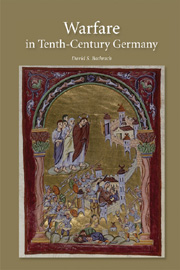Book contents
- Frontmatter
- Contents
- List of Illustrations
- Acknowledgments
- Abbreviations
- Introduction
- 1 Restoring Francia Orientalis: Henry I's Long Term Strategy
- 2 Forging a New Empire
- 3 Military Organization
- 4 Military Education
- 5 Arms and Training
- 6 Morale
- 7 Tactics on the Battlefield
- 8 Campaign Strategy: The Civil War of 953–954
- Conclusion
- Appendix: Major Military Operations by Henry I, Otto I, and Their Commanders
- Bibliography
- Index
- Warfare in History
Conclusion
Published online by Cambridge University Press: 05 February 2013
- Frontmatter
- Contents
- List of Illustrations
- Acknowledgments
- Abbreviations
- Introduction
- 1 Restoring Francia Orientalis: Henry I's Long Term Strategy
- 2 Forging a New Empire
- 3 Military Organization
- 4 Military Education
- 5 Arms and Training
- 6 Morale
- 7 Tactics on the Battlefield
- 8 Campaign Strategy: The Civil War of 953–954
- Conclusion
- Appendix: Major Military Operations by Henry I, Otto I, and Their Commanders
- Bibliography
- Index
- Warfare in History
Summary
During their combined fifty-four years of rule, Henry I and Otto I used war as a basic tool of government in the pursuit of their medium and long-term policy objectives. War, for the early Ottonian kings, was not a pastime, nor was it primarily a means to provide their magnates with access to booty and plunder. The consistent, although not absolute, success of Ottonian armies against the West Franks, Danes, Slavic polities east of the Saale and Elbe rivers, Bohemians, Hungarians, Lombards, Byzantines, and within East Francia/Germany itself led to a fundamental reorientation of political authority throughout the Latin West. Henry I successfully resuscitated the East Frankish kingdom of Arnulf of Carinthia and Louis the German, raising it to a hegemonic status among the successor states of the Carolingian empire. He also extended his power eastwards into lands that never were incorporated into the regnum Francorum.
Otto I, building on the political and military achievements of his father, maintained the hegemonic role of the eastern kingdom in the affairs of both West Francia and Burgundy. He also gained control of the Lombard kingdom, as well as the papal state, and lands even further south up to the frontiers of Calabria and Apulia. In so doing, Otto re-established Charlemagne's empire, and justified both politically and militarily his claim to have brought about a renovatio imperii. Moreover, Otto went even further than his Carolingian model, and established direct military control over the vast swath of lands between the lower Elbe and the Oder river.
- Type
- Chapter
- Information
- Warfare in Tenth-Century Germany , pp. 254 - 256Publisher: Boydell & BrewerPrint publication year: 2012

